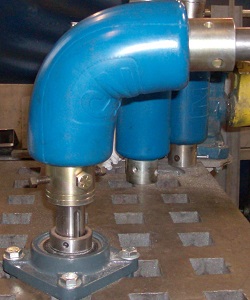NS Flex Coupling Maintenance
Mar 15th 2017

Background: The NS Flex Coupling was designed specifically for transit and car wash machines by our owner/founder Thomas Ennis to withstand the rigors and abuse seen in drive through wash systems. The coupling is designed and tested to 12,000 pounds pulling force and flexibility up to 90 degrees under the most extreme conditions. Our Flex Coupling, unlike other brush coupling in our industry, does not require lubrication or continual adjustment. Under normal operation, it will last over ONE MILLION vehicle washes.
Following are a few tips to keep your Flex Coupling operating correctly, as well as some signs that a coupling should be replaced.
1. Correct brush contact pressure against the vehicle will minimize torsional load as well as minimize brush wear and possible vehicle damage.
2. Correct spacing between vehicles through the wash system will eliminate accidental pinching of the brush between two vehicles, which will cause excessive binding loads that will start shearing the mechanical rubber bond between the internal wire braided cable and metal yokes at each end.
3. Correct vehicle speed during initial brush contact should not exceed 1.5 miles per hour. Ramming the brushes will create a momentary stall situation, which can cause torsional shearing to internal mechanical bonds as well as torsional stress loads to the internal stranded wire braided cable.
4. Replace a Flex Coupling if there are any visible cracks on the encapsulating rubber. Cracks are a sign of extreme flexing and/or dry-rot caused by age or harsh chemicals. Cracks in a coupling may not hinder its ability to continue performing normally, but they are an obvious sign of damage. Cracks will also allow for water ingress, which can cause internal corrosion that will eventually damage internal components that keep the brush from falling.
5. Replace a Flex Coupling if there is any noticeable deformity to the mounting bolt holes. Deformed/elongated mounting holes are a clear indication of prolonged torsional load damage. To check for mounting hole damage, grab the brush and rotate it side to side. If the brush rotates but the coupling does not, this would indicate damage to the Flex Coupling mounting holes or support hardware.
6. Replace a Flex Coupling if there is extreme separation of the mechanical rubber bond to the metal yoke at each end. To check for rubber to metal yoke separation, you can push the brush towards the wash bay entrance to see if the rubber separates from the metal yoke at the top or bottom of the coupling. If there is a gap larger than 1/8” and a flat screw driver with a 3/16 blade width can be pushed in between the rubber and the metal more than a 5/8” into the gap, the coupling should be replaced. If the gap depth is less than 5/8 ” but a gap is present, the coupling should be routinely inspected and replaced if the gap increases.
